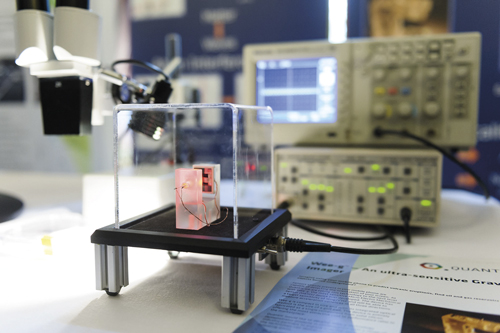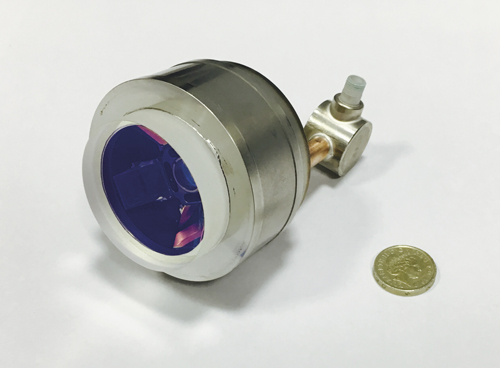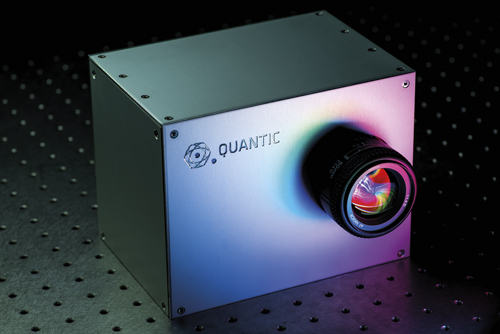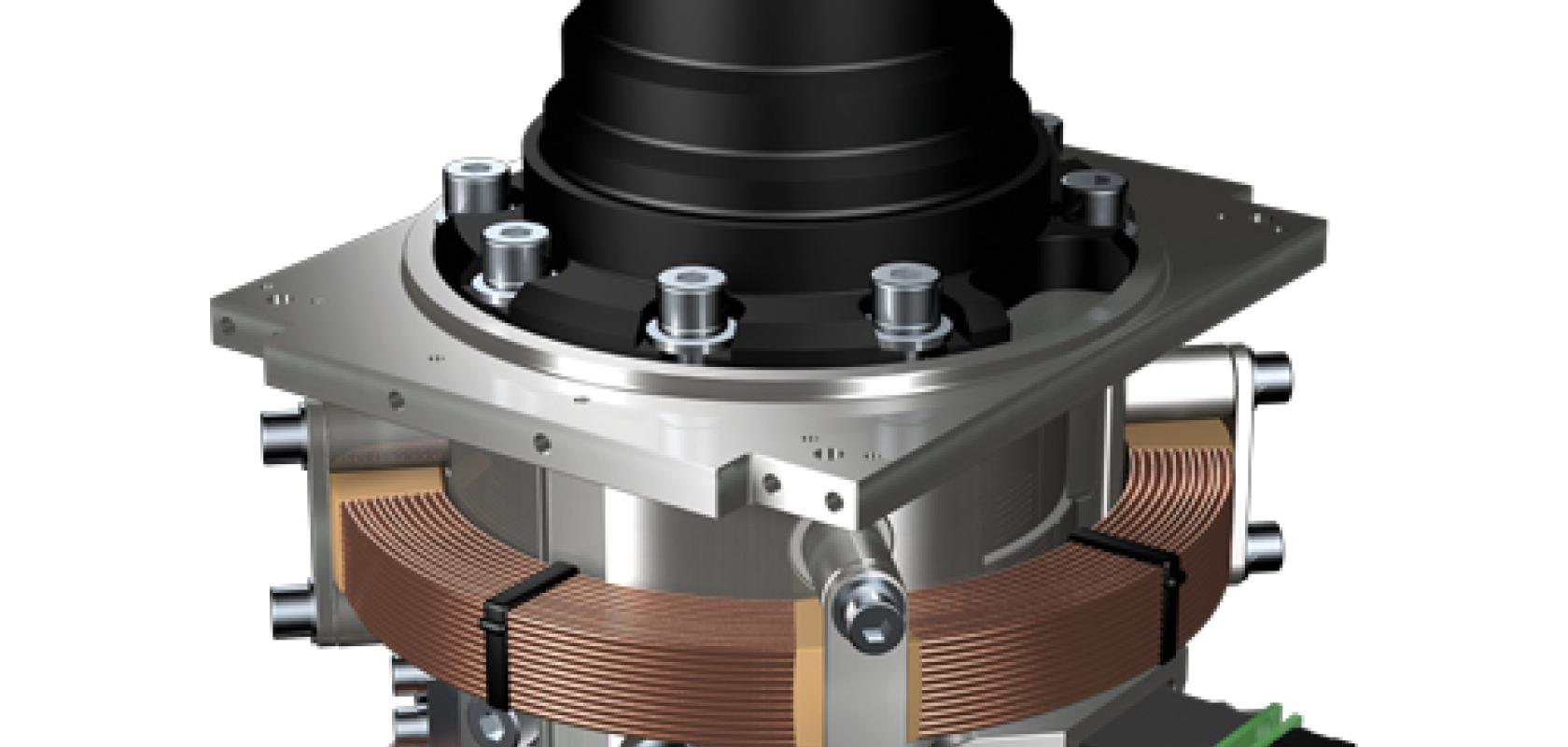Caption: Teledyne e2v's gravity sensor relies on inversion algorithms to form an image
What will power the cameras of the future? Quantum sensing might be one class of imager that looks set to make its way onto the market in the next few years, sooner than you might think, in some cases.
There’s a huge amount of investment in quantum technologies, the most high profile of which is arguably quantum computing – Intel announced a 49-qubit supercomputing quantum test chip at the 2018 Consumer Electronics Show in Las Vegas at the beginning of January – but there are advances being made in quantum communications and quantum sensing. The European Commission has opened the first calls for projects within its €1 billion quantum flagship programme, which is set to last 10 years, while the UK launched its quantum programme back in 2014, funded by the Engineering and Physical Sciences Research Council (EPSRC), which has been one of the success stories of UK science.
The UK programme is made up of four hubs, of which quantum enhanced imaging, or Quantic, is one. A consortium of seven universities and more than 30 companies, Quantic has projects building gravity meters, gas sensing cameras and cameras that can sense around corners, some of which are close to commercial deployment.
What is quantum imaging? The term is quite hard to pin down as it covers such a wide variety of technologies, most of which don’t use classical image sensors and are therefore more sensing than imaging, in some respects. However, they all measure an array of points and as such can be said to produce images of whatever it is they are detecting.
The quantum part of the technologies being worked on in projects overseen by Quantic can be just as broad. Certain aspects of quantum imaging are truly quantum, whereas others are arguably a bit more remote.
True quantum sensing involves quantum superposition, which is when an object is in two states simultaneously – when an atom is in both the ground and excited states at once, for example. Richard Murray, business development manager for quantum technologies at Teledyne e2v, explained that ‘these superposition effects are remarkably sensitive to the outside world, so they can be used to make very good sensors.’ Teledyne e2v has a team of 25 people working on commercialising quantum sensor technologies, including quantum gravity sensors and quantum clocks.
To create quantum superposition effects requires objects that are isolated from the background environment, normally produced either by cooling atoms in a vacuum to fractions of a degree above absolute zero, or by using nitrogen vacancy centres in diamond. These can then be manipulated with laser light to create quantum effects that are sensitive to subtle changes in the local gravity, magnetic field and time.
Teledyne e2v’s gravity sensor is being developed in partnership with the University of Birmingham as part of project Reveal, which aims to build a quantum gravimeter for subterranean surveying in civil engineering. ‘The potential applications are really exciting,’ said Murray. ‘Imaging using gravity can help you detect objects with different densities hidden or forgotten under the ground. It can help to discover forgotten pipes and cables, it can help to discover mineral deposits, image the foundations of a house or structural damage on a bridge. It can help search for archaeological ruins, such as hidden chambers in the pyramids of Giza.’
Quantum detectors for measuring gravity are far more sensitive than any other gravity sensor currently on the market, according to Murray. Within the Quantic hub, Professor Giles Hammond at the University of Glasgow is building a quantum gravimeter with a target sensitivity of 10ng/√Hz – the device is able to measure the change in gravity in a lift travelling from one floor to the next, or measure the gravitational field between two people standing next to each other.
The Wee-g gravity sensor is based on quantum micro-electro-mechanical systems (MEMS), which are essentially a very small mass on a spring. The oscillation frequency of these springs changes with different gravitational fields. The quantum effect here comes from using quantum light to read out the movement of the MEMS spring very sensitively.

The Wee-g gravity sensor is based on quantum micro-electro-mechanical systems. Credit: EPSRC/Dan Tsantilis
Wee-g is about the size of a matchbox; it is being developed with industry partners Qinetiq, Bridgeporth, Schlumberger and Clyde Space.
Conventional instruments that can measure gravity at the sensitivity of Wee-g are available but cost £250,000, according to Professor Miles Padgett at the University of Glasgow and Quantic’s principal investigator. Also, conventional gravity meters record just a single point, so are more like a light meter than a camera. ‘If you want to measure gravity at multiple positions simultaneously, i.e. to record an image, then you need a sensor network that doesn’t cost £250,000 per pixel,’ Padgett said.
‘Once you have an image you can learn a lot more about what’s underneath you than a single point ever can tell,’ he continued. ‘Once you’ve got multiple sensors you are able to detect a lot more interesting things. You can detect magma flow; gravity sensing is used quite extensively by petrochemical companies to prospect for oil – measuring at multiple points gives you a better picture.’
Teledyne e2v’s gravimeter relies on inversion algorithms to take data from multiple points and turn this into an image. This is because, unlike light, there are no gravitational lenses that you can use. ‘For gravity, which is a force that cannot be screened, and is very long range, this is a highly complex problem and current researchers are looking at complex Bayesian logic for answers,’ explained Murray.
Gas imaging
One of the Quantic projects reasonably close to commercialisation is a single-pixel camera for gas sensing being developed by M Squared Lasers. Nils Hempler, head of innovation at M Squared, said that the company is now getting close to trialling the Gas Sight sensors in alpha programmes with end-users in industry, and is looking for partners to do the final stage of development. ‘We’ve done a lot of internal validation on this and side-by-side comparison to our big systems and also competing systems,’ he said, adding that M Squared hopes to get into beta testing within the next year or so.
M Squared has worked a lot in the quantum sphere, initially selling sophisticated lasers to scientists working in quantum research. It has also developed chemical sensing devices based on backscattered absorption spectroscopy in collaboration with the UK Defence Science and Technology Laboratory (DSTL). The chemical sensors operate by illuminating the scene with a mid-infrared laser; two active mirrors then raster scan to detect backscattered radiation with a single photodetector. The device is able to register the presence of substances like VX nerve gas down to microlitre droplets. M Squared’s quantum imaging work is an overlap between the two areas.

Teledyne e2v's miniaturised vacuum system on which it bases its quantum sensors
‘The gas sensing technology we’ve been working on over the last seven to eight years, together with DSTL, is prohibitively expensive for some emerging applications, such as environmental monitoring,’ explained Hempler. ‘The technology that’s been developed in the Quantic hub can potentially reduce the cost point into the few-thousand-pounds bracket. That’s where you’re starting to address a lot wider market.’
M Squared’s Gas Sight camera is a single-pixel shortwave infrared camera operating between 1-2µm. Many gases absorb in the SWIR region. The camera, which has applications in the oil and gas industry, among others, can detect gases leaking from the ground or a pipeline.
Single-pixel cameras differ from traditional cameras in that the image sensor is replaced with a single photodiode in front of a micro-mirror array, which encodes a series of binary patterns. Armed with knowledge of the patterns, an image can be deduced through data inversion. This gets around some of the issues associated with the scanning mirror pair used in the chemical sensors M Squared has been working on with DSTL. It is also of particular benefit when operating in the mid and far infrared where array detectors are expensive.
The resolution of Gas Sight depends on how many patterns are run; thousands are needed for an image. The device operates at 32 x 32 pixels at 20 fps, and can produce real-time video of methane gas, sensing at 1.65µm, at a distance of one metre.
The key part of M Squared’s gas sensing technology – and where it has underpinning IP – is combining single pixel imaging with active illumination. The scene is illuminated with a laser and the gas absorption spectra are measured from the returning light.
Gas Sight could not be called a true quantum instrument, but it’s in the UK quantum programme because the technology can do things like correlated imaging, time-resolved imaging, and detect single photons. Where Gas Sight would become truly quantum would be if it were to use squeezed light – a non-classical state of light.
This is effectively a question of which light source is used to illuminate the scene. A standard laser has noise characteristics, which limits shot noise and detection characteristics. Squeezed light, on the other hand, can get below the shot noise limit, which gives incredibly high signal-to-noise ratio and improved sensitivity. There’s a lot of work that is happening in various labs to develop these sorts of sources. This is still, however, very much a research activity.
‘As far as our effort is concerned, at the moment it’s classical imaging with a twist, which is the single pixel aspect and the patterned illumination that we’re using,’ Hempler said.
Commercialising quantum
Hempler puts the global market for selling components and systems into quantum science as being set to rise to a $1 billion market within the next five to ten years. ‘There’s a huge commercial opportunity,’ he said. ‘We’ve worked with the quantum community for a number of years; we know exactly what they are after, and so we’re in a prime position to exploit this and become a cornerstone of the UK supply chain, and we’d argue the global supply chain that’s currently forming.’

M Squared Laser's Gas Sight camera is a single-pixel shortwave infrared camera operating between 1-2 microns
Dr Graeme Malcolm OBE, CEO of M Squared, is sitting on the industrial high-level steering committee for the European quantum flagship programme.
‘The goal of the Quantic hub is to accelerate the transition of cutting-edge emerging technologies into the commercial space,’ commented University of Glasgow’s Padgett. Other projects at the hub include a detection system that can sense objects around a corner, which is being developed by Thales alongside Professor Robert Henderson, at the University of Edinburgh. The system works by bouncing laser light off the floor, which scatters in all directions and some of which returns from objects around the corner. The properties of the returning light can give information about the size and shape of the unseen objects. ‘What you need to do that [image the scattered light], is have a camera that is incredibly sensitive – able to detect single photons – and with an incredibly short shutter speed – a timing resolution of around 50 picoseconds,’ explained Padgett. ‘That’s state-of-the-art.’ The system can sense objects 50 metres ahead and a few metres around a corner.
The hub also has a project on 3D imaging for situation awareness being led by Leonardo, a hi-tech company in Edinburgh, and with components supplied by Horiba. ‘Quantic has a market opportunities panel made up of 14 companies, which considers the component chain and who will eventually sell the system,’ explained Padgett.
‘What’s impressed me is the degree to which the companies have engaged and have actively co-invested in a number of these projects. Collectively, they see the opportunity too,’ he added.
‘In order to start becoming a commercial reality, quantum technologies need to leave the lab and start being trialled and used out in the environment,’ said Murray at Teledyne e2v. This is not straightforward, he said, as the devices need to be built from components that are both at the very cutting-edge of electronics and photonics, but also durable and, preferably, at a satisfactory cost. ‘The engineering work that will allow for this will take some time to come to fruition.’
Murray continued: ‘For certain industries, no one will really know what the real life performance will be until full testing and field trials have been carried out. This means that the applications and markets for the newly developed, quantum-enabled capabilities will take time to emerge and become adopted. Therefore, market building exercises are also needed, as are creative individuals that can discover the next inspired applications.’


